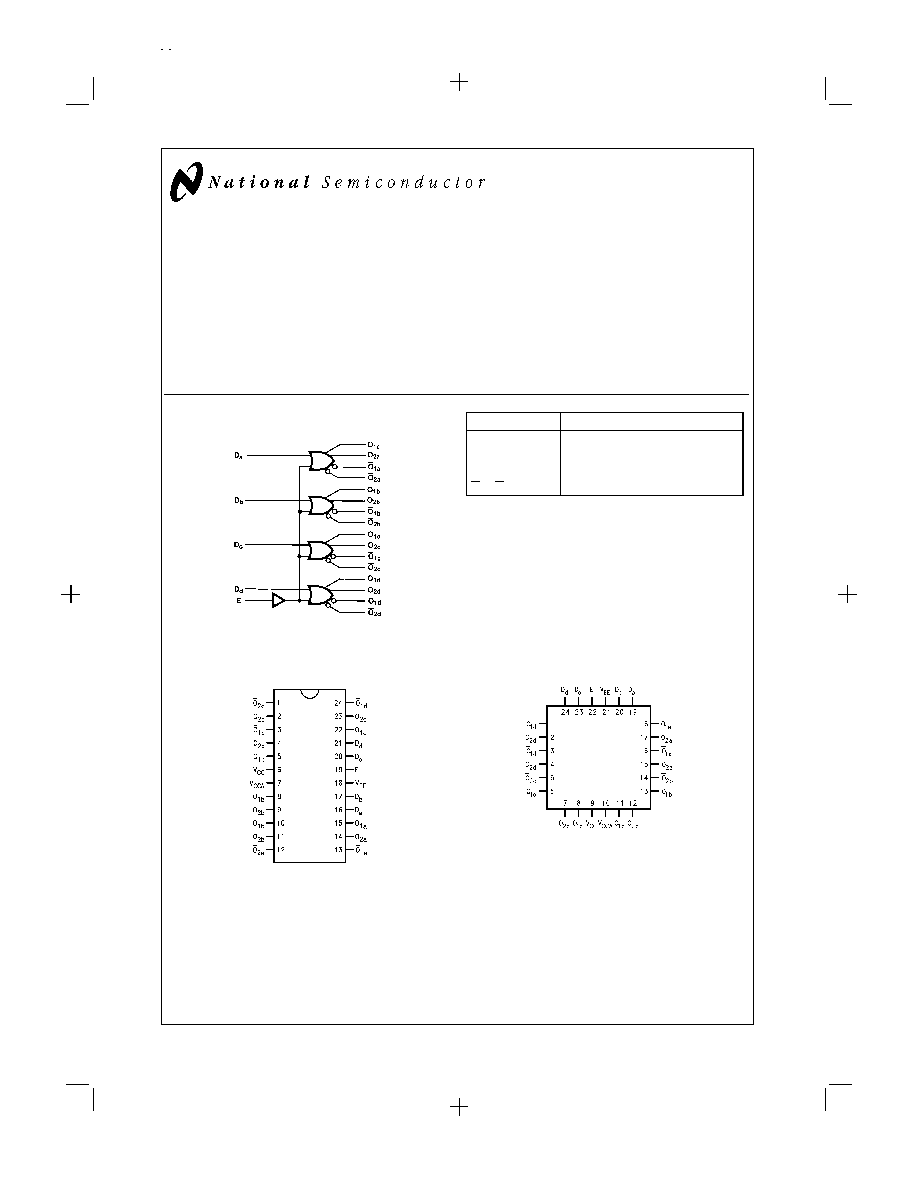
100313
Low Power Quad Driver
General Description
The 100313 is a monolithic quad driver with two OR and two
NOR outputs and common enable. The common input is
buffered to minimize input loading. If the D inputs are not
used the Enable can be used to drive sixteen 50
lines. All
inputs have 50 k
pull-down resistors and all outputs are
buffered.
Features
n
50% power reduction of the 100113
n
2000V ESD protection
n
Pin/function compatible with 100113 and 100112
n
Voltage compensated operating range = -4.2V to -5.7V
n
Standard Microcircuit Drawing
(SMD) 5962-9673201
Logic Symbol
Pin Names
Description
D
a
�D
d
Data Inputs
E
Enable Input
O
na
�O
nd
Data Outputs
O
na
�O
nd
Complementary Data Outputs
Connection Diagrams
DS100297-3
24-Pin DIP
DS100297-1
24-Pin Flatpak
DS100297-2
August 1998
100313
Low
Power
Quad
Driver
100313
� 1998 National Semiconductor Corporation
DS100297
www.national.com
1
PrintDate=1998/08/31 PrintTime=07:05:03 45028 ds100297 Rev. No. 1
cmserv
Proof
1
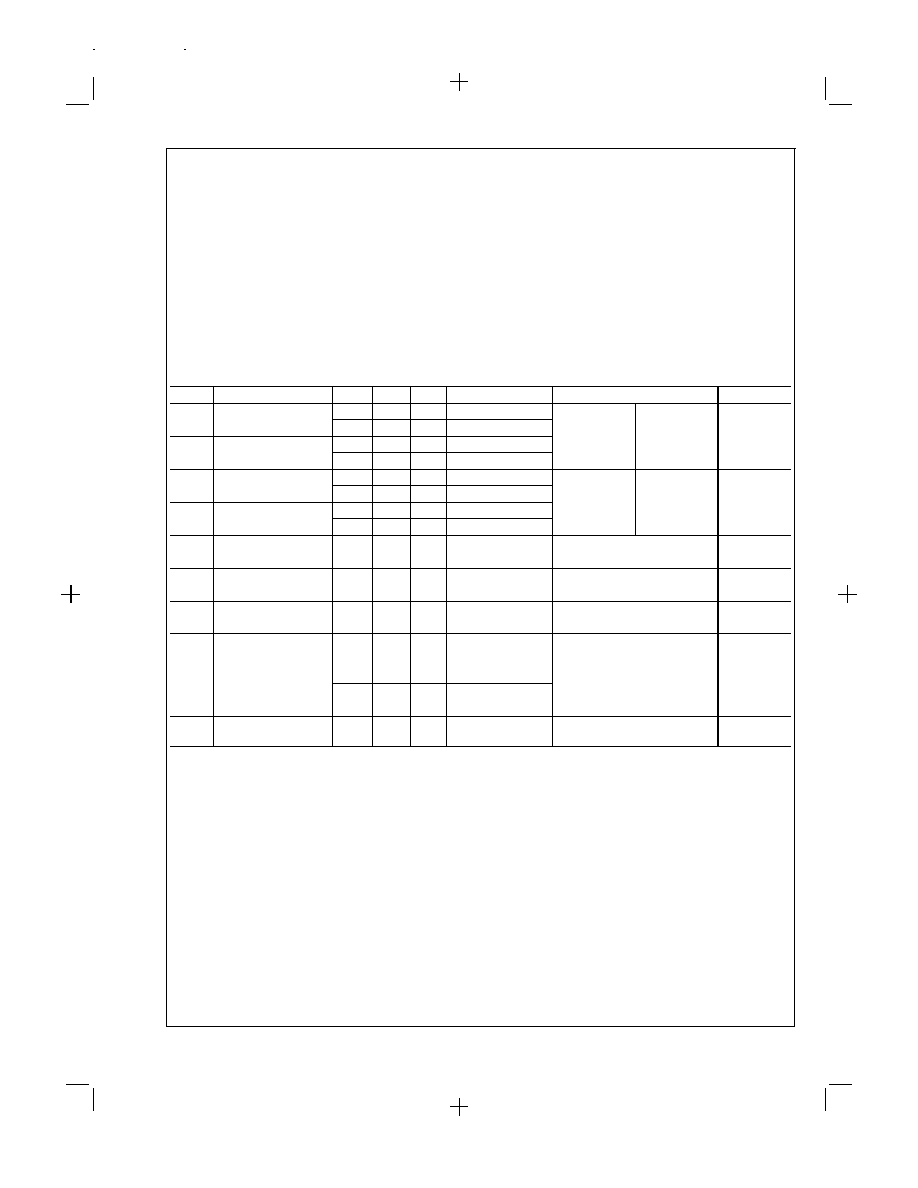
Absolute Maximum Ratings
(Note 1)
If Military/Aerospace specified devices are required,
please contact the National Semiconductor Sales Office/
Distributors for availability and specifications.
Storage Temperature (T
STG
)
-65�C to +150�C
Maximum Junction Temperature (T
J
)
Ceramic
+175�C
V
EE
Pin Potential to Ground Pin
-7.0V to +0.5V
Input Voltage (DC)
V
EE
to +0.5V
Output Current (DC Output HIGH)
-50 mA
ESD (Note 2)
2000V
Recommended Operating
Conditions
Case Temperature (T
C
)
Military
-55�C to +125�C
Supply Voltage (V
EE
)
-5.7V to -4.2V
Note 1: Absolute maximum ratings are those values beyond which the de-
vice may be damaged or have its useful life impaired. Functional operation
under these conditions is not implied.
Note 2: ESD testing conforms to MIL-STD-883, Method 3015.
Military Version
DC Electrical Characteristics
V
EE
= -4.2V to -5.7V, V
CC
= V
CCA
= GND, T
C
= -55�C to +125�C
Symbol
Parameter
Min
Max
Units
T
C
Conditions
Notes
V
OH
Output HIGH Voltage
-1025
-870
mV
0�C to +125�C
-1085
-870
mV
-55�C
V
IN
=V
IH (Max)
Loading with
(Notes 3, 4,
5)
V
OL
Output LOW Voltage
-1830 -1620
mV
0�C to +125�C
or V
IL(Min)
50
to -2.0V
-1830 -1555
mV
-55�C
V
OHC
Output HIGH Voltage
-1035
mV
0�C to +125�C
-1085
mV
-55�C
V
IN
=V
IH (Min)
Loading with
(Notes 3, 4,
5)
V
OLC
Output LOW Voltage
-1610
mV
0�C to +125�C
or V
IL (Max)
50
to -2.0V
-1555
mV
-55�C
V
IH
Input HIGH Voltage
-1165
-870
mV
-55�C to +125�C
Guaranteed HIGH Signal
(Notes 3, 4,
5, 6)
for All Inputs
V
IL
Input LOW Voltage
-1830 -1475
mV
-55�C to +125�C
Guaranteed LOW Signal
(Notes 3, 4,
5, 6)
for All Inputs
I
IL
Input LOW Current
0.50
�A
-55�C to +125�C
V
EE
= -4.2V
(Notes 3, 4,
5)
V
IN
= V
IL (Min)
I
IH
Input HIGH Current
Data
350
�A
0�C to +125�C
Enable
240
V
EE
= -5.7V
(Notes 3, 4,
5)
Data
500
�A
-55�C
V
IN
= V
IH (Max)
Enable
340
I
EE
Power Supply Current
-65
-20
mA
-55�C to +125�C
Inputs Open
(Notes 3, 4,
5)
Note 3: F100K 300 Series cold temperature testing is performed by temperature soaking (to guarantee junction temperature equals -55�C), then testing immediately
without allowing for the junction temperature to stabilize due to heat dissipation after power-up. This provides "cold start" specs which can be considered a worst case
condition at cold temperatures.
Note 4: Screen tested 100% on each device at -55�C, +25�C, and +125�C, Subgroups 1, 2, 3, 7, and 8.
Note 5: Sample tested (Method 5005, Table I) on each manufactured lot at -55�C, +25�C, and +125�C, Subgroups A1, 2, 3, 7, and 8.
Note 6: Guaranteed by applying specified input condition and testing V
OH
/V
OL
.
www.national.com
2
PrintDate=1998/08/31 PrintTime=07:05:03 45028 ds100297 Rev. No. 1
cmserv
Proof
2
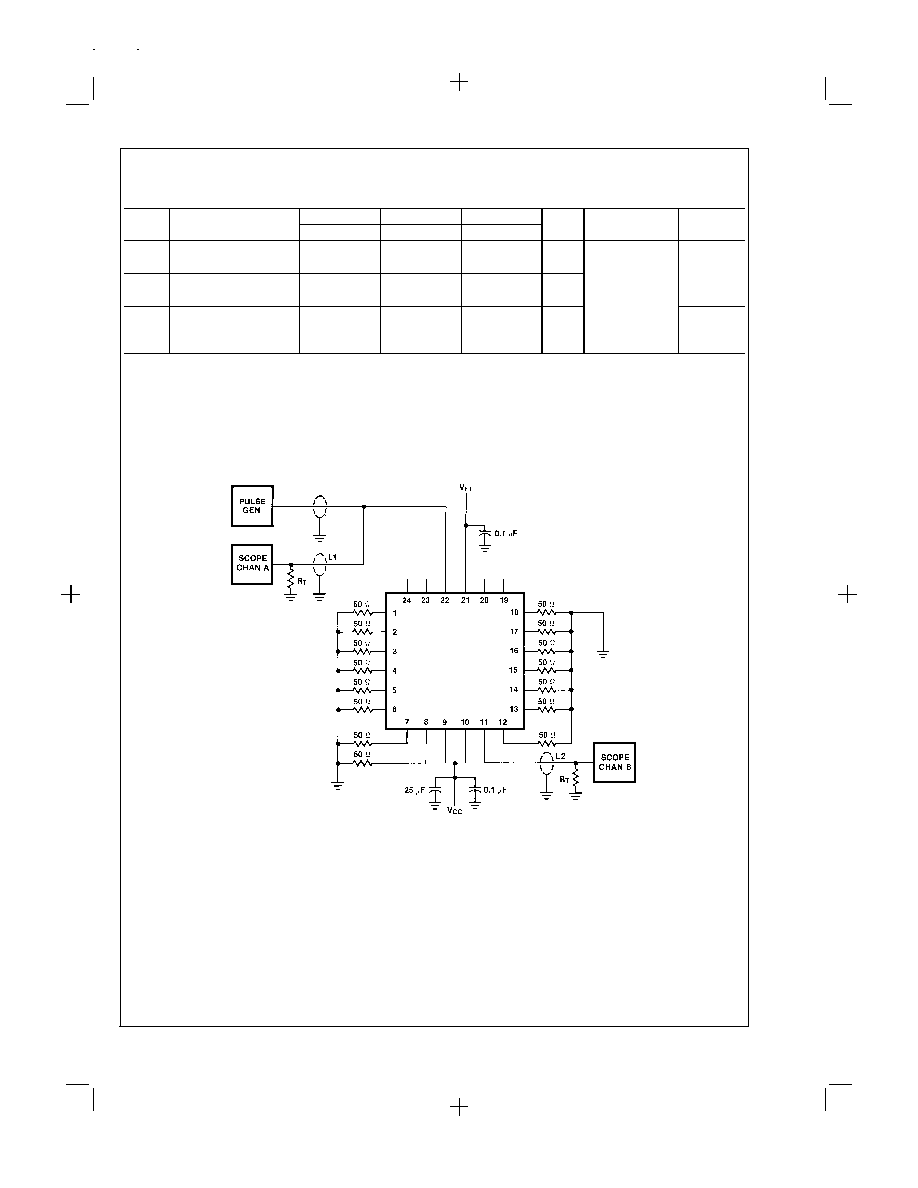
Military Version
AC Electrical Characteristics
V
EE
= -4.2V to -5.7V, V
CC
= V
CCA
= GND
Symbol
Parameter
T
C
= -55�C
T
C
= +25�C
T
C
= +125�C
Units
Conditions
Notes
Min
Max
Min
Max
Min
Max
t
PLH
Propagation Delay
0.30
2.00
0.30
1.80
0.30
2.30
ns
(Notes 7,
8, 10, 11)
t
PHL
Data to Output
t
PLH
Propagation Delay
0.50
2.40
0.60
2.30
0.60
2.70
ns
Figures 1, 2
t
PHL
Enable to Output
t
TLH
Transition Time
0.30
2.00
0.30
1.90
0.30
2.00
ns
(Note 10)
t
THL
20% to 80%, 80% to
20%
Note 7: F100K 300 Series cold temperature testing is performed by temperature soaking (to guarantee junction temperature equals -55�C), then testing immediately
after power-up. This provides "cold start" specs which can be considered a worst case condition at cold temperatures.
Note 8: Screen tested 100% on each device at +25�C, Subgroup A9.
Note 9: Sample tested (Method 5005, Table I) on each manufactured lot at +25�C, Subgroup A9, and at +125�C and -55�C temperatures, Subgroups A10 and A11.
Note 10: Not tested at +25�C, +125�C, and -55�C temperature (design characterization data).
Note 11: The propagation delay specified is for single output switching. Delays may vary up to 150 ps with multiple outputs switching.
Test Circuitry
DS100297-5
Notes:
V
CC
, V
CCA
= +2V, V
EE
= -2.5V.
L1 and L2 = equal length 50
impedance lines.
R
T
= 50
terminator internal to scope.
Decoupling 0.1 �F from GND to V
CC
and V
EE
.
All unused outputs are loaded with 50
to GND.
C
L
= Fixture and stray capacitance
3 pF.
Pin numbers shown are for flatpak; for DIP see logic symbol.
FIGURE 1. AC Test Circuit
www.national.com
3
PrintDate=1998/08/31 PrintTime=07:05:04 45028 ds100297 Rev. No. 1
cmserv
Proof
3
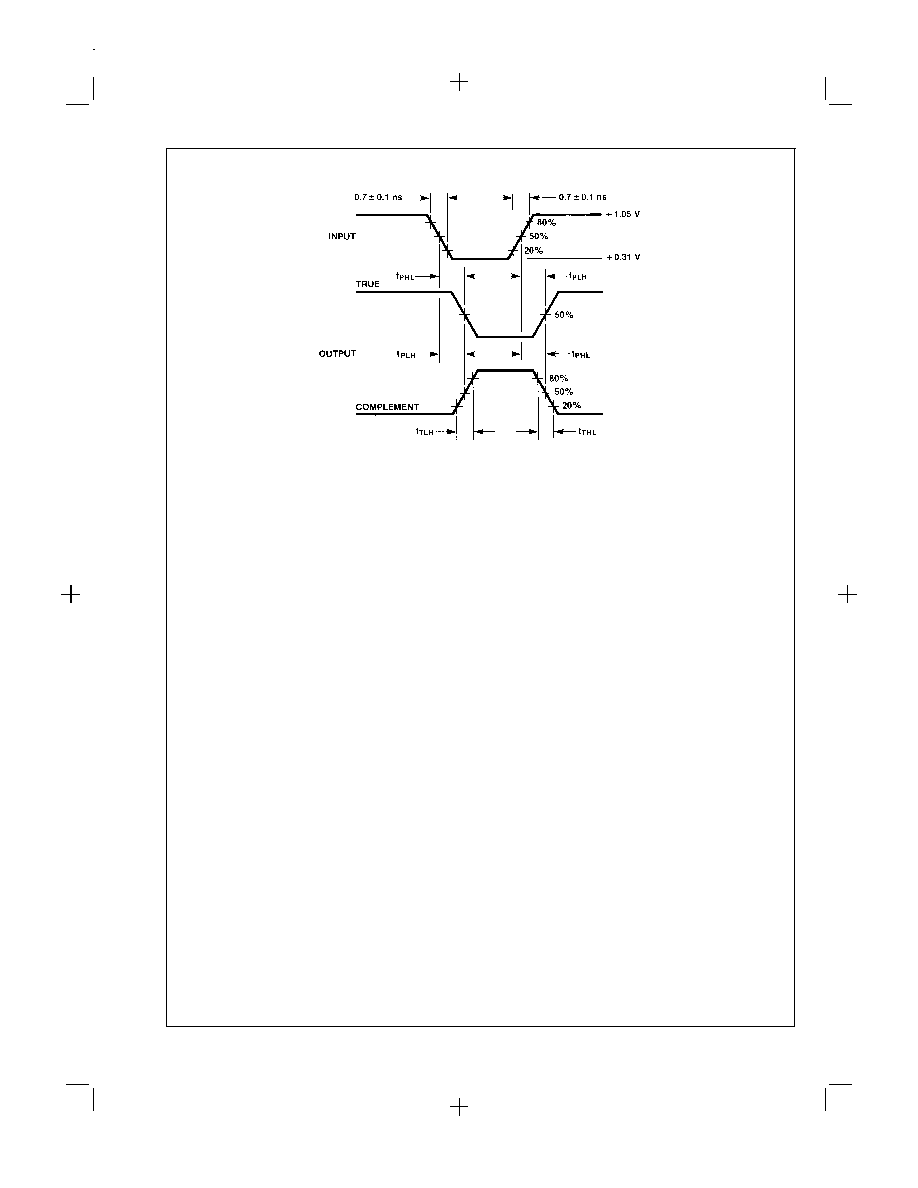
Switching Waveforms
DS100297-6
FIGURE 2. Propagation Delay and Transition Times
www.national.com
4
PrintDate=1998/08/31 PrintTime=07:05:04 45028 ds100297 Rev. No. 1
cmserv
Proof
4
Book
Extract
End
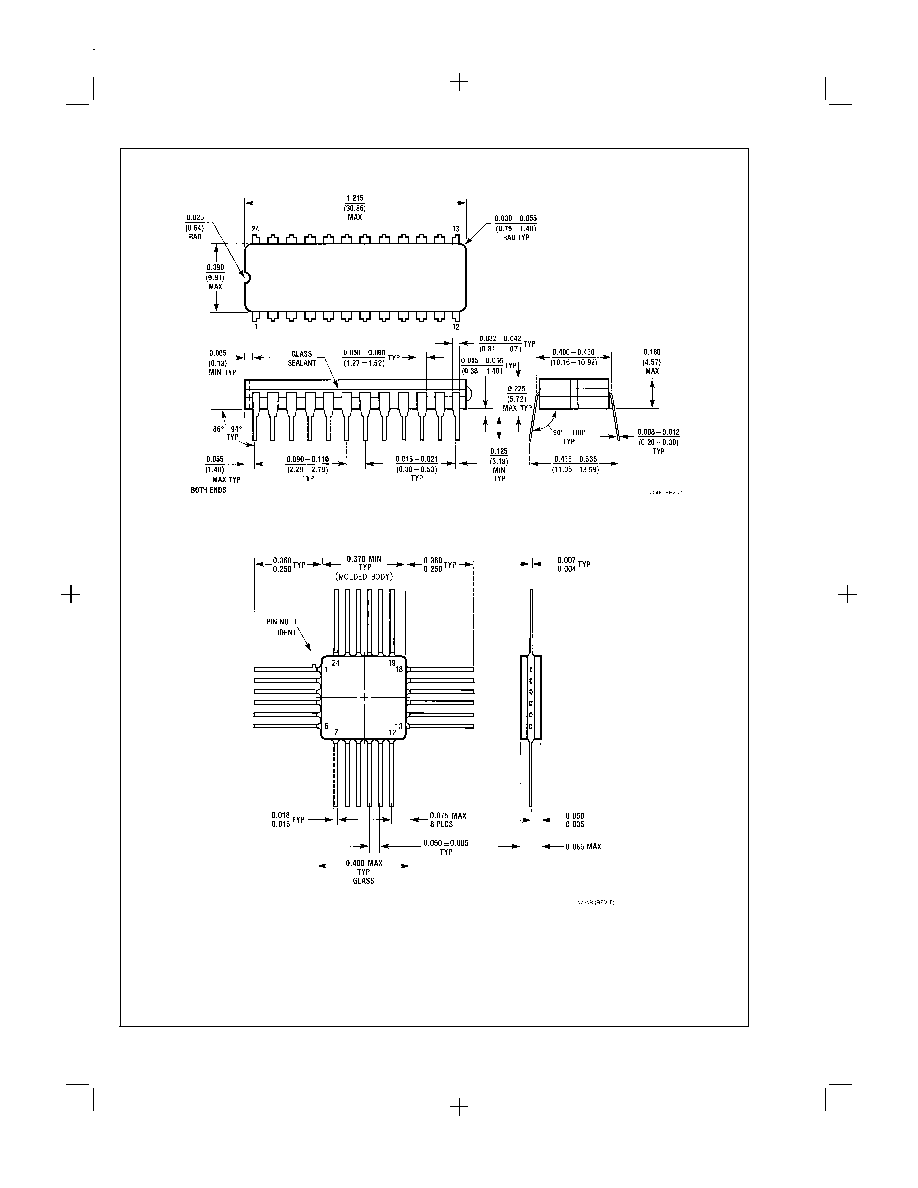
Physical Dimensions
inches (millimeters) unless otherwise noted
24-Pin Ceramic Dual-In-Line Package (D)
NS Package Number J24E
24-Pin Quad Cerpak (F)
NS Package Number W24B
www.national.com
5
PrintDate=1998/08/31 PrintTime=07:05:04 45028 ds100297 Rev. No. 1
cmserv
Proof
5




